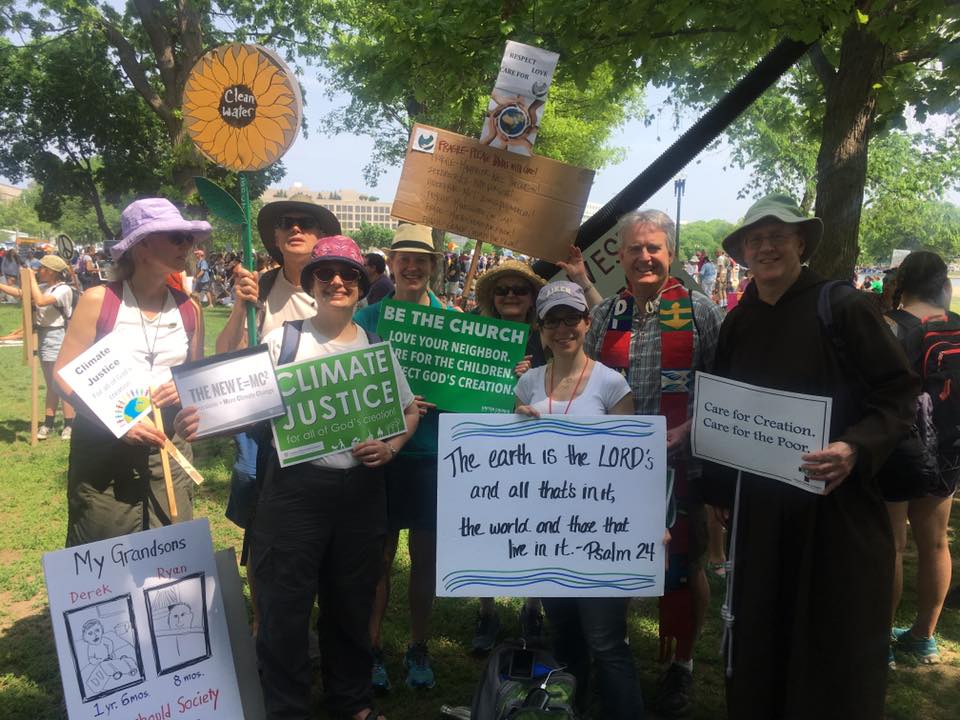by Rev. Tom Carr
One week after tens of thousands of people took part in the March for Science in Washington, DC and hundreds of others cities around the world, 200,000 people representing a wide variety of interests and concerns gathered for the People’s Climate March crowding Pennsylvania Avenue from the Capitol to the White House to demand action on the climate crisis now rapidly unfolding around the world. Eight members of the Board of IREJN joined with thousands of people of multiple religious traditions and spiritualities as part of the Keepers of Faith contingent expressing our deep concern from our moral, ethical and spiritual perspectives about the devastation of God’s planet and people, particularly the poor and most vulnerable. Ironically, it was in the low 90s on April 29th as we were demanding that the U.S. government adhere to the Paris Climate agreements whose goal is to keep temperature rises below 1.5 C.
The March had been in the planning stages since early summer of 2016 for the 100th day of whoever would become the next President of the United States. With the election of Donald Trump and his appointments to key positions charged with protecting the environment, human justice and health, the March took on greater urgency. Along with the great energy, the amazingly creative signs, the chants and songs, what struck and delighted me was the diversity of people, organizations and interests represented. Indigenous communities, human justice organizations, labor, education, environment, religious, and many others marched because there is a recognition that human justice and ecological wholeness are one issue, “two sides of the same coin.” This is why the Interreligious Eco-Justice Network has the “Eco-Justice” in it. There can be no human justice without ecological health and there will be no ecological health without justice for all people, everywhere. This is also why the most impacted peoples already bearing the brunt of the early effects of climate change led the march – indigenous peoples, poor people, people of color and others.
The March was another important, very public event to gather people of common concern and commitment to express our demands that our elected officials act on the fact that climate change is real and is the great existential threat to life as we know it. It was meant to empower and encourage people all over the country and the world to get active in many ways. First, to consider one’s personal lifestyle, one’s carbon footprint and work to live a more sustainable life at home, business, in one’s congregation, in financial investments, one’s diet, one’s purchases, etc. Secondly, to become actively engaged in the political process to be in constant contact with elected officials demanding actions that will significantly reduce the burning of fossil fuels. Visit their offices by yourself or better, with others. Third, run for office yourself – locally, statewide, nationally. Make climate change (and species extinction and toxins) THE “issue” for elected officials. Fourth, talk with people who trust you -friends, family, co-workers, people in your congregation – and show them how much this means to you and why. You don’t have to be a climate scientist and/or know all the details about climate change to show people who trust you how close this is to your heart. Tell your story. Fifth, consider engaging in non-violent, civil disobedience related to the extraction of fossil fuels, pipelines, fracking, etc. Finally, share your faith conviction about this with your congregation. Share with your congregation why you believe “The Earth is the Lord’s” and why we are called to be faithful stewards of all creation.
The People’s Climate March was another beginning and a call to bold action for the sake of God’s human and other than human creation. I hope you’ll join in this good work.
